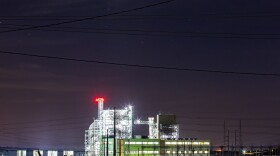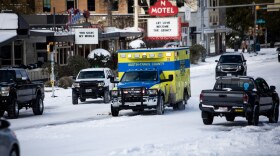When the February winter storm hit Austin and power outages left thousands without heat for days, some Austinites felt like they couldn’t turn to the city for help, according to a new report.
Over the past few months, the city’s Winter Storm Review Task Force has been gathering information from residents about their experiences during the storm. The task force, made up of volunteers from various city commissions and committees, held listening sessions and collected written feedback from the community.
The task force presented its final report to the Austin City Council on Tuesday. It shows people felt the city was unprepared, and that residents struggled to get crucial, clear information from officials, ultimately making some lose trust in authorities.
“Once the storm was hitting, there was inadequate and inconsistent communications about where the power was out and how long it would be out for, where people could get food and other resources, and how they could also protect their home infrastructure,” Jeffrey Clemmons, one of the task force members, said during the presentation.
The report shows people felt texting services and radio communications were under-utilized, with the city opting to rely more heavily on social media tools like Facebook Live videos. But many residents lacked power to charge their devices and connect to the internet.
“All forms of media and emergency response systems should be used to reach the community,” the report says. “The city should contact citizens rather than relying on citizens to contact the city.”
Residents also thought the city should have communicated more information about the storm ahead of the event and with more urgency to help residents make a plan. Throughout the storm, they felt the information they were getting about power and water outages was often contradictory. For example, what was at first called “rolling” or “intermittent black-outs” turned into days without power, the report notes.
The Electric Reliability Council of Texas, the state's grid operator, asked electricity suppliers during the storm to cut their power usage because of high demand. ERCOT has said the amount of electricity it needed to cut was so great, the blackouts could not be rotated.
The report also says it was “jarring” for people to watch broadcasts from city leaders in well-lit, heated spaces. It notes there were news conferences in which Mayor Steve Adler appeared to be in a well-lit area and City Manager Spencer Cronk was wearing a short-sleeved shirt.
“We were all being told to work together to conserve energy so power could start to be restored safely, while [Mayor Adler] was on camera flagrantly doing the opposite,” a respondent, Lawrence Williams, is quoted saying in the report. “I remember this viscerally, because at the time I was under three blankets, except for the hand holding the phone. To my knowledge, he never apologized or commented on his action in that moment of severe crisis.”
People were also frustrated to see unoccupied offices and parking garages lit up downtown, when people were being told to conserve energy and many residential areas were without power.
Clemmons said the task force heard from people who felt there was inequity in who got to keep their power and who did not.
“There’s a need to improve the equity in terms of our distribution of power in the city of Austin, since there were some communities that lost power for much longer than others,” Clemmons said. “And the reasons for that likely go back to our equity in terms of infrastructure.”
The report recommends the city install charging stations that use alternate sources of power so people can charge phones and computers during disasters like this one.
People also struggled to get through to emergency services, according to the task force’s chair Sareta Davis. Calls to 311 went unanswered, or the line had extremely long hold times, she said.
“It really caused a frenzy and fear because I think it made the situation worse,” Davis said. “They basically felt helpless and like they were left alone.”
People were also confused about who to get help from — city, county, state or federal officials. Davis said people had the impression that city officials were "passing the buck," or shifting blame off to other officials.
“So, [residents] didn’t really know who to turn to for help,” Davis said. “But it became increasingly obvious that they felt like they could not turn to anyone with the city for any substantive help.”
People were also frustrated that the city didn’t do more to make roads accessible during the freeze and that emergency services vehicles weren’t always able to get to people. The report recommends the city have a better plan for emergency services to be able to function during a critical weather event like February's winter storm.
“It's a very hard pill to swallow for the citizens of Austin that their emergency services could not help them because they did not know how to help them,” Davis said. “No one was prepared to hear that.”
Davis said the task force did hear positive feedback about the city’s response; some people were able to get assistance from the city and said that some officials “rose to the challenge.” But, she said, they want most of them to be held accountable for their failures.
“We’re several months out from the storm now,” Davis said. “And citizens still feel that the city hasn’t really given them a response that shows that they believe they are responsible for some of the failures and that things will be better in the future.”
After the presentation, Mayor Pro-Tem Natasha Harper-Madison said city officials worked “long and hard” to help people during the storm, but she, too, was disappointed in the city’s response.
“This is me extending an official apology on behalf of this body, my colleagues included, for what we weren’t able to do as a municipality, what we weren’t able to do as a body, to know what we needed to know in order to execute more effectively, efficiently and expediently,” Harper-Madison said.
City Manager Spencer Cronk said the city is taking steps to be better prepared in the future. He said Austin Energy, Austin Water and the city’s emergency operations departments have been doing internal reviews since the storm.
The city is also working with a consultant to compile a formal “after action report” that’s expected to be completed by the end of September. The report is supposed to help the city determine how it can improve its response to future emergencies.
“But we were not waiting for that report,” Cronk said. “Already many of our departments are actively responding to resilience efforts, ways that we can improve the effectiveness and the ability to ensure that when this happens again, we are prepared.”









